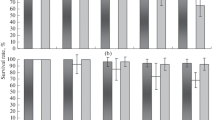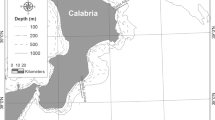Abstract
The reproduction of Eurytemora velox, a brackish copepod from temporary lakes of the south of France, was studied in winter and spring 1978, under various temperature and salinity conditions, using Chlorella sp. and Amphidinium sp. as food. Maximum numbers of successive eggs sacs (9), eggs per sac (39.3) and total egg production per female (311) were recorded for the witner generation, only 4.8, 34.8 and 109, respectively, for the spring generation. In contrast, the number of eggs per female per day was highest (11.3) in the spring generation, which displayed a more rapid reproductive cycle. Despite strong individual variations in the rhythm of egg sac production and in abundance of eggs per sac, egg production was generally higher during the first third of adult life, attaining a maximum after production of the second or the third egg sac. The continuous presence of the males was necessary to assure complete fertilization of eggs throughout the whole life of adult females. Hatching rate displayed high individual variability, in particular for the spring generation, which had lower average hatching rates (between 0 and 26%, depending on salinity or temperature) than the winter generation (14 to 64%). These differences may be related to the ability of E. velox to produce resting eggs during spring, allowing the species to maintain itself in a temporary water milieu. Temperature significantly affected longevity and daily egg production of females; presence or absence of males did not affect these parameters. An increase in salinity from 20 to 30%. reduced longevity, number of egg sacs, and daily egg production in the winter generation, but not in the spring generation. The specific daily production of females during their adult life was calculated from the egg production:biomass ratio of females, in carbon units. In the winter generation, this ratio increased between 10° and 15°C compared to ratios between 15° and 20°C; the opposite was observed for the spring generation. The seasonal differences in the effects of temperature and salinity on reproduction could indicate an adaptation mechanism to the strongly thermal and haline seasonal fluctuations which characterize the habitat of Ex. velox (brackish waters, drying-up in summer). Larval mortality was high, except at 20%. S for the spring generation. The sex-ratio of the offspring was unaffected by variations in breeding conditions. Hatching time and development time of larvae could be described by two Bělehrádek equations displaying close b and (α) coefficients. We calculated the energy balance of adult females from data obtained in a previous study on feeding and respiration in E. velox, and this is discussed in context with the egg production results. Net growth efficiency varied with algal concentration according to an asymptotic curve, reaching a maximum of 0.43 with Tetraselmis maculata as food or 0.53 with Amphidinium sp. Actual egg production rate obtained in the present study was in good agreement with that calculated by the difference between assimilated food and respiration expenses.
Similar content being viewed by others
Littérature citée
Abou Debs C. et P. Nival: Etude de la ponte et du développement embryonnaire en relation avec la température et la nourriture chez Temora stylifera Dana (Copepoda: Calanoida). J. exp. mar. Biol. Ecol. 72, 125–145 (1983)
Bělehrádek, J.: Temperature and living matter. Protoplasma-Monogr. 8, 1–277 (1935)
Butler, E. I., E. D. S. Corner and S. M. Marshall: On the nutrition and metabolism of zooplankton. VI. Feeding efficiency of Calanus in terms of nitrogen and phosphorus. J. mar. biol. Ass. U.K. 49, 977–1001 (1969)
Champeau, A.: Recherches sur l'écologie et l'adaptation à la vie latente des copépodes des eaux temporaires provencales et corses, 360 pp. Thèse Doctorat des Sciences, Université Aix-Marseille 1970
Corkett, C. J. and I. A. McLaren: Relationships between development rate of eggs and older stages of copepods. J. mar. biol. Ass. U.K. 50, 161–168 (1970)
Corner, E. D. S. and A. G. Davies: Plankton as a factor in the nitrogen and phosphorus cycles in the sea. Adv. mar. Biol. 9, 101–204 (1971)
Dagg, M. J.: Complete carbon and nitrogen budgets for the carnivorous amphipod Calliopus laeviusculus (Krøyer). Int. Revue ges. Hydrobiol. 61, 297–357 (1976)
Gaudy, R.: Etude expérimentale de la ponte chez trois espèces de copépodes pélagiques (Centropages typicus, Acartia clausi et Temora stylifera). Mar. Biol. 9, 65–70 (1971)
Gaudy, R. et J. P. Guérin: Dynamique des populations de Tisbe holothuriae (Crustacea: Copepoda) en élevage sur trois régimes artificiels différents. Mar. Biol. 39, 137–145 (1977)
Gaudy, R. et J. P. Guérin: Etude expérimentale de la respiration, de la croissance, de la fécondité de Tisbe holothuriae (Copépode: Harpacticoïde) élevé à des températures différentes. In: Physiology and behaviour of marine organisms, pp 31–38. Ed. by D. S. McLusky and A. J. Berry. Oxford, New York: Pergamon Press 1978
Harris, R. P.: Feeding, growth, reproduction and nitrogen utilization by the harpacticoïd copepod Trigriopus brevicornis. J. mar. biol. Ass. U.K. 53, 785–800 (1973)
Harris, R. P.: Some aspects of the biology of the harpacticoid copepod Scottolana canadensis (Willey) maintained in laboratory culture. Chesapeake Sci. 18, 45–252 (1977)
Harris, R. P. and G.-A. Paffenhöfer: The effect of food concentration on cumulative ingestion and growth efficiency of two small planktonic copepods. J. mar. biol. Ass. U.K. 56, 875–888 (1976)
Heinle, D. R.: Population dynamics of exploited cultures of calanoïd copepods. Helgoländer wiss. Meeresunters. 20, 360–372 (1970)
Heinle, D. R., R. P. Harris, J. F. Ustach and D. A. Flemer: Detritus as food for estuarine copepods. Mar. Biol. 40, 341–353 (1977)
Jacobs, J.: Laboratory cultivation of the marine copepod Pseudodiaptomus coronatus, Willams. Limnol. Oceanogr. 6, 443–446 (1961)
Katona, S. K.: Copulation in the copepod Eurytemora affinis (Poppe, 1880). Crustaceana 28, 89–95 (1975)
Marshall, S. M. and A. P. Orr: Food and feeding in copepods. Rapp. P.-v. Réun. Cons. perm. int. Explor. Mer 153, 92–98 (1962)
McLaren, I. A., C. J. Corkett and E. J. Zillioux: Temperature adaptation of copepod eggs from arctic to the tropics. Biol. Bull. mar. biol. Lab., Woods Hole 137, 486–493 (1969)
Nassogne, A.: Influence of food organisms, on the development and culture of pelagic copepods. Helgoländer wiss. Meeresunters. 20, 333–345 (1970)
Pagano, M.: Observations sur le cycle annuel d'Eurytemora velox (Lilljeborg, 1853), copépode calanoïde des mares saumâtres de Camargue. Rapp. P.-v. Réun. Commn int. Explor. Scient. Mer Méditerr. 27, 145–146 (1981)
Pagano, M. et R. Gaudy: Biologic d'un copépode des mares temporaires du littoral méditerranéen français: Eurytemora velox. I. Nutrition. Mar. Biol. 90, 551–564 (1986a)
Pagano, M. et R. Gaudy. Biologie d'un copépode des mares temporaires du littoral méditerranéen français: Eurytemora velox. II. Respiration et excrétion. Mar. Biol. 93, 127–136 (1986b)
Parrish, K. K. and D. F. Wilson: Fecundity studies on Acartia tonsa (copepoda: Calanoida) in standardized culture. Mar. Biol. 46, 65–81 (1978)
Urry, D. L.: Observations on the relationship between food and survival of Pseudocalanus elongatus in the laboratory. J. mar. biol. Ass. U.K. 45, 49–58 (1965)
Uye, S. I.: Fecundity studies of neritic calanoid copepods Acartia clausi Giesbrecht and A. steueri Smirnov: a simple empirical model of daily egg production. J. exp. mar. Biol. Ecol. 50, 255–271 (1981)
Vidal, J.: Physioecology of zooplankton. IV. Effects of phytoplankton concentration, temperature, and body size on the net production efficiency of Calanus pacificus. Mar. Biol. 56, 203–211 (1980)
Whitehouse, J. W. and B. G. Lewis: The effect of diet and density on development size and egg production in Cyclops abyssorum Sars, 1863 (Copepoda: Cyclopoïda). Crustaceana 25, 215–236 (1973)
Wilson, D. F. and K. K. Parrish: Remating in a planktonic marine calanoid copepod. Mar. Biol. 9, 202–204 (1971)
Author information
Authors and Affiliations
Additional information
Communicated by J. M. Pérès, Marseille
Rights and permissions
About this article
Cite this article
Gaudy, R., Pagano, M. Biologie d'un copépode des mares temporaires du littoral méditerranéen français: Eurytemora velox. Mar. Biol. 94, 335–345 (1987). https://doi.org/10.1007/BF00428239
Accepted:
Published:
Issue Date:
DOI: https://doi.org/10.1007/BF00428239




